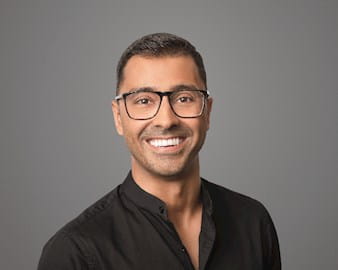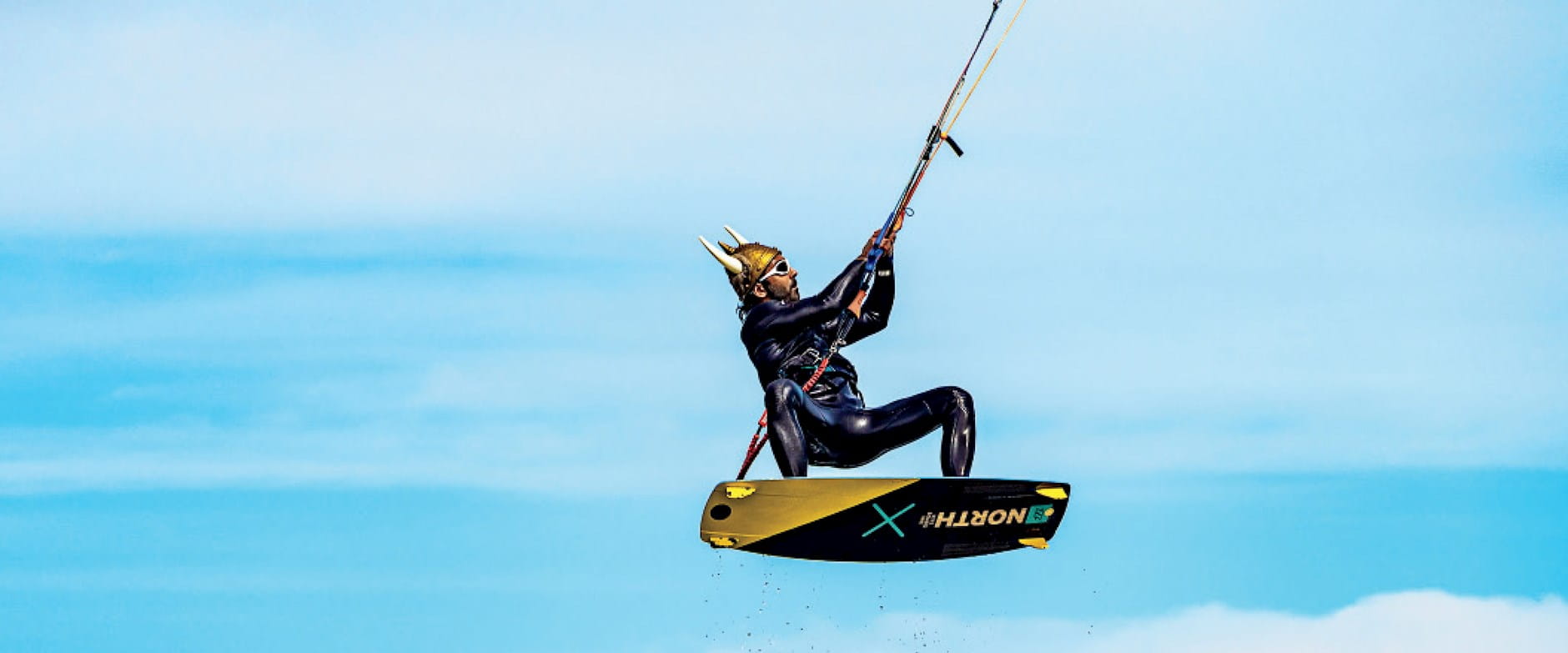After a weeklong kiteboarding class in Mexico three years ago, Mohit “Mo” Bhasin, ’15, was finally ready to try the sport on his own back in San Francisco. He’d spent nearly $5,000 kitting himself out with equipment, including a beautiful canary yellow Cabrinha kite. He headed to 3rd Avenue, a classic beginner’s spot.
“A person inflated my kite and launched it into the air, and I am trying to maneuver it closer to the water, and it’s not working,” he remembered. “And everyone is looking at me like, ‘Who is this fool?’”
In those situations, he had learned, the thing to do is hit the release to make the kite fall to the ground—but he suddenly realized that in his excitement to get on the water, he’d forgotten to attach the kite to the harness around his chest. He watched as the kite flew away across a golf course. “I had to run after it in my wetsuit and sunglasses as people were swinging six irons and yelling ‘Fore!’” he laughed. “There’s actually a story in the Bay Area about not buying a yellow Cabrinha. I’m not 100 percent certain the story is about me—but I’m pretty sure.”
Despite that early misfire, Bhasin has since thrived in the sport, riding the waves and catching air everywhere from Mexico to Spain. He’s even navigated treacherous spots such as San Francisco Bay beneath the Golden Gate Bridge, where kiteboarders must tackle strong currents and passing cargo ships. “It’s such an iconic location—it was absolutely epic the first time I did it!” he enthused.
Whether it’s skirting container ships or starting his own data analytics company, Bhasin has always enjoyed pushing himself to his limits—and yellow Cabrinha aside, it’s usually paid off for him. “I probably have a little bit of imposter syndrome. I am always asking myself, ‘Can I hack it here?’” Bhasin said. “‘How far can I go to prove to myself that I’m capable of doing this?’”
“I am always asking myself, ‘Can I hack it here? How far can I go to prove to myself that I’m capable of doing this?’”
— Mo Bhasin

Originally from Mumbai, India, he came to the United States thinking he’d get into sustainable technology. After studying materials science and engineering at the University of California, Berkeley, and mechanical engineering at Texas A&M, he got into product management instead—and when he took a stats class at Booth with then professor Robert Gramacy, he fell in love with the challenge.
“It was one of those things that seemed daunting and intimidating,” he said. Gramacy, now at Virgina Tech, and former econometrics and statistics professor Matt Taddy, now at Amazon, encouraged him to pursue a career in data analytics, and Bhasin took advantage of the flexible curriculum to take classes in computer science and public policy as well. After graduation, he landed a job in analytics with Nest, the Palo Alto, California-based smart-home company later acquired by Google.
Kiteboarding consists of a small board strapped to the feet, along with a harness around the chest attached to an enormous inflatable kite flying some 65 to 90 feet overhead that pulls the rider along. The related sport of kitesurfing uses a different board that only travels in one direction, while kiteboards can ride in both.
It was watching fellow Boothie Conor Fernandez, ’15, kiteboarding that excited Bhasin about the sport for the first time. “I love the water. It looked like an extreme sport, and it looked challenging,” he said. After taking a few classes while on vacation, he finally dove in with a weeklong course in 2018 in La Ventana, a kiteboarding mecca north of Cabo San Lucas, Mexico. “In the beginning, you are just eating dirt,” he said. “It was like the sixth or seventh day when I finally picked it up.”
Working in San Francisco, he was able to leave early on Fridays to explore more than a dozen local kiteboarding spots; the area has one of the highest concentrations in the United States. “When you are out on the water, there’s just a huge sense of joy on your face. You see turtles in the water, giant fish, sometimes dolphins,” he said. “It’s just a completely rewarding break from city life.” Despite the extreme nature of the sport, Bhasin said, being out on the waves is surprisingly meditative. “It focuses all of your energy on this one thing you are doing.”
Last February he left Google, and by the end of the year, he decided to start his own data analytics company with Gurudev Karanth, a former data analytics director with Minneapolis-based Target. While they are raising funds and organizing the San Carlos, California-based company, called OutoftheBlue.ai, Bhasin has taken to a “vagabond lifestyle,” spending three months in the Dominican Republic, and planning future travel to Spain or South Africa to continue kiteboarding in his spare time. Along the way, he’s met many other kiteboarders, who are often Silicon Valley residents themselves. “People have called it the ‘new golf,’” he said. “People hobnob and meet over kiteboarding.”
As he keeps pushing himself in the sport, Bhasin has been taking higher jumps—recently as high as 20 feet. He’s excited to learn cooler tricks, such as the Jesus Walk, in which a kiteboarder temporarily leaves the board and literally walks across the waves, or something called a Dark Slide. “You throw your legs back and your kite forward, and are just skimming acoss the surface with your board off the water,” he described.
While kiteboarding will be officially part of the Olympic Games for the first time in Paris in 2024, Bhasin isn’t interested in formal competition. He just wants to keep pushing his personal limits. “I’ve managed to find something that gives me a lot of happiness,” he said. “I’ll keep doing this as long as I can.”
Mo’s Tips
Thinking of taking up kiteboarding? Take it from Mo:
Commit some time—and money—to it. “It’s not something that you can do in Tulum, Mexico, for a weekend, or learn in a couple of hours. You need to be committed to it, and devote four or five days to it, minimum. If you have some extra cash lying around, there are ways you can learn it more quickly. You can get helmets with walkie-talkies so the instructor can talk to you in the water, or a premier version of learning when someone is on a Jet Ski with you, helping you if you lose your board or your kite.”
Start on land. “If you have a good instructor, you spend a lot of time on the beach practicing what you are going to do when you get in the water. You sit down with one leg pointed forward, and practice diving the kite down, which gives you enough momentum to get up on your board—without pushing yourself too hard that you face plant. Once you’ve got that down, you’ve got that muscle memory to reenact the same experience in the water.”
Celebrate small victories. “You’ve got to have an attitude that appreciates making progress: whether you are able to get your board back, or maintain your kite in a fixed position. Just saying, ‘I’ve got this. I’m making progress,’ and believing in yourself is key until you are able to be out there independently.”
Take calculated risks. “After you are comfortable riding in both directions, the next thing you want to do is start jumping. It takes a little extra courage to pull up and get off the water. Usually people have too much courage and really hurt themselves early on, and then they won’t try those tricks for a long time—or they don’t have enough courage to try it to begin with. It’s a fine line and a kind of balancing act. But while you can injure yourself, it’s not like mountain biking where you can fall off a cliff. It’s just water, right? Be careful, but also be willing to take the jump.”


